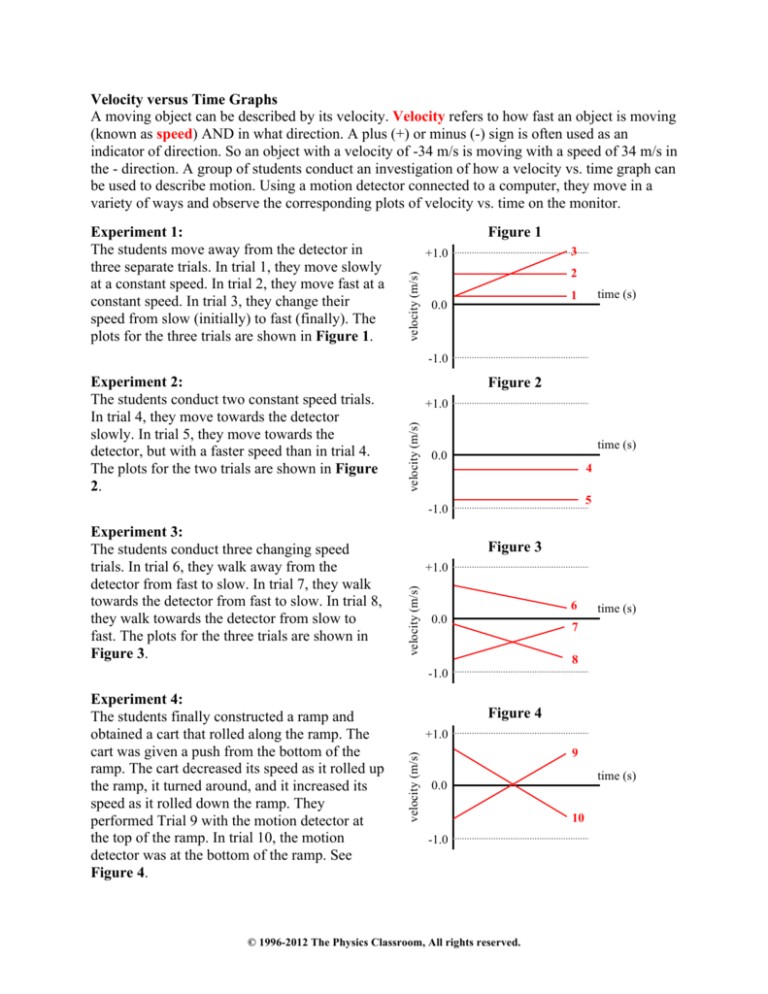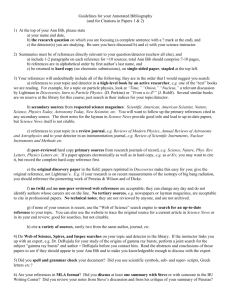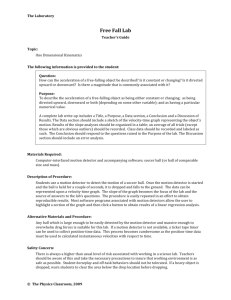
Velocity versus Time Graphs
A moving object can be described by its velocity. Velocity refers to how fast an object is moving
(known as speed) AND in what direction. A plus (+) or minus (-) sign is often used as an
indicator of direction. So an object with a velocity of -34 m/s is moving with a speed of 34 m/s in
the - direction. A group of students conduct an investigation of how a velocity vs. time graph can
be used to describe motion. Using a motion detector connected to a computer, they move in a
variety of ways and observe the corresponding plots of velocity vs. time on the monitor.
Figure 1
3
+1.0
velocity (m/s)
Experiment 1:
The students move away from the detector in
three separate trials. In trial 1, they move slowly
at a constant speed. In trial 2, they move fast at a
constant speed. In trial 3, they change their
speed from slow (initially) to fast (finally). The
plots for the three trials are shown in Figure 1.
2
time (s)
1
0.0
-1.0
Figure 2
+1.0
velocity (m/s)
Experiment 2:
The students conduct two constant speed trials.
In trial 4, they move towards the detector
slowly. In trial 5, they move towards the
detector, but with a faster speed than in trial 4.
The plots for the two trials are shown in Figure
2.
time (s)
0.0
4
5
-1.0
Figure 3
+1.0
velocity (m/s)
Experiment 3:
The students conduct three changing speed
trials. In trial 6, they walk away from the
detector from fast to slow. In trial 7, they walk
towards the detector from fast to slow. In trial 8,
they walk towards the detector from slow to
fast. The plots for the three trials are shown in
Figure 3.
6
0.0
time (s)
7
8
-1.0
Figure 4
+1.0
velocity (m/s)
Experiment 4:
The students finally constructed a ramp and
obtained a cart that rolled along the ramp. The
cart was given a push from the bottom of the
ramp. The cart decreased its speed as it rolled up
the ramp, it turned around, and it increased its
speed as it rolled down the ramp. They
performed Trial 9 with the motion detector at
the top of the ramp. In trial 10, the motion
detector was at the bottom of the ramp. See
Figure 4.
9
time (s)
0.0
10
-1.0
© 1996-2012 The Physics Classroom, All rights reserved.
© 1996-2012 The Physics Classroom, All rights reserved.
Questions:
1. How do the lines on the velocity-time graph differ for moving towards the motion detector
compared to moving away from the motion detector?
a. When moving towards the detector, the line slopes upward; when moving away from the
detector, the line slopes downward.
b. When moving towards the detector, the line slopes downward; when moving away from
the detector, the line slopes upward.
c. When moving towards the detector, the line is above the axis; when moving away from
the detector, the line is below the axis.
d. When moving towards the detector, the line is below the axis; when moving away from
the detector, the line is above the axis.
2.
After completing Experiment 1, students concluded that a fast object is represented by a
line that is higher on the graph. How must this conclusion be modified (if at all) in order to
be consistent with the results from Experiment 2?
a. A fast object is represented by a line that is far above or far below the time axis.
b. A fast object is represented by a line that is diagonal and finishes high on the graph.
c. There is no need to modify the conclusion since it is consistent with both experiments.
d. Nonsense! The students were wrong from the beginning. A fast object has a large slope.
3.
What information is provided by the observations in Experiment 2 that was not provided by
observations in Experiment 1?
a. Experiment 2 shows what the velocity-time plots look like when objects slow down.
b. Experiment 2 shows what the velocity-time plots look like when objects move fast.
c. Experiment 2 shows what the velocity-time plots look like for constant speed motion.
d. Experiment 2 shows what the velocity-time plots look like when objects move towards
the detector.
4.
Based on the plotted velocity values in Experiment 4, how is the negative (-) direction
defined?
a. The negative direction is up the hill.
b. The negative direction is down the hill.
c. The negative direction is towards the motion detector.
d. The negative direction is away from the motion detector.
5.
What vital information is provided by the observations in Experiment 4 that were not
provided by observations in the other three experiments?
a. Experiment 4 reveals how the graph looks when objects are at rest.
b. Experiment 4 reveals how the graph looks when objects slow down.
c. Experiment 4 reveals how the graph looks when objects change their direction.
d. Experiment 4 reveals how the graph looks when objects other than people move.
© 1996-2012 The Physics Classroom, All rights reserved.
Which statement below describes the line on a velocity-time graph for any object that is
slowing down?
a. The line is diagonal and sloping downward.
b. The line is diagonal and located in the negative (-) velocity region.
c. The line is diagonal and sloping downward and located in the negative (-) velocity region.
d. The line is diagonal and in either + or – velocity region, but sloping towards the time axis.
7.
Based on Experiment 4, what conclusion can be made regarding the line on a velocity-time
graph for an object that is changing direction?
a. The line has an upward slope and then a downward slope, or vice versa.
b. The line begins above the axis and later is below the axis, or vice versa.
c. The line begins as a diagonal line and changes to a curved line, or vice versa.
d. The line begins as a horizontal line and changes to a diagonal line, or vice versa.
8.
As the group of students continued to
experiment, they produced a variety of
+1.0
different graphs. One of them looked like
the graph at the right. Which statement
time (s)
describes how they moved to create the
0.0
velocity-time graph at the right?
a. They moved slowly; then changed
directions and moved fast.
-1.0
b. They moved away from the detector
slowly at a constant speed; then they moved much faster in the same direction.
c. They moved away from the detector slowly at a constant speed; then they moved much
faster, but in a different direction than before.
d. Starting from rest, they moved away from the detector while speeding up; they then
continued speeding up but at a more rapid rate.
9.
As the group of students continued to
+1.0
experiment, they produced a variety of
different graphs. One of them looked like
time (s)
the graph at the right. Which statement
0.0
describes how they moved to create the
velocity-time graph at the right?
a. They moved away from the detector at a
-1.0
constant speed; then they moved towards
the detector at a constant speed.
b. They moved towards the detector at a constant speed; then they moved away from the
detector at a constant speed.
c. They moved from slow to fast in one direction; then they moved from fast to slow in the
opposite direction.
d. They moved towards the detector while speeding up; then they moved towards the
detector while slowing down.
velocity (m/s)
velocity (m/s)
6.
© 1996-2012 The Physics Classroom, All rights reserved.






